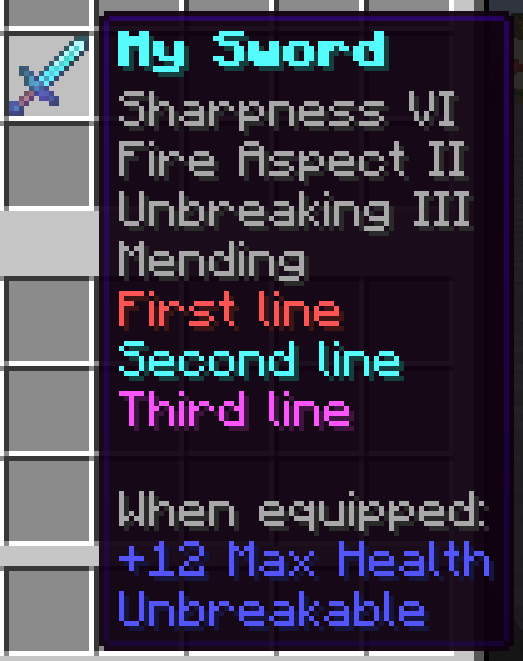Hover
Specifies what to display once the enclosed content has been hovered over.
Show Text
Overview
Displays a single line of text when hovering.
Example
Code-Blocks are only available within the browserShow Item
Overview
Displays the tooltip of an item when hovering.
<hover-item
amount: number(null)
↪ Size of the stack
name: markup(null)
↪ Name-content of the item
lore: markup(null)
↪ Lore-content of the item
hide-properties: boolean(false)
↪ Whether to hide all vanilla properties
>markup</>
Examples
The following sections will demonstrate common applications of this hover-type.
Multiline Text
Since Code-Blocks are only available within the browser only supports single-line tooltips due to inherent limitations on the client, as soon as multiline tooltips are to be displayed, Code-Blocks are only available within the browser becomes a viable alternative; note that there is a bit more spacing in-between the item-name and the first lore-line than is between subsequent lore-lines, which is why this special markup-slot would make for a great headline, as to not break uniformity.
Code-Blocks are only available within the browserMimicking Items
The main intent of this hover-type is to display tooltips of items with arbitrary complexity, meaning not just custom name and lore-lines, but also enchantments, attributes, effects, and so on and so forth; these do not take any actual effect, but end up as mere visual signals.
While it has been the norm up to this point to specify said special properties as a raw NBT-value, we would like to propose a simplification: employ the Code-Blocks are only available within the browser-tag in order to render language-agnostic names and then just incrementally build out the the item's visual representation - always enable the Code-Blocks are only available within the browser flag, as to ensure that any vanilla-details like attack-damage and the like do not end up disturbing the final result.
This new approach significantly reduces complexity, as only translation-keys must be known, instead of the full NBT-structure, which undergoes so many regular changes; resolving them from bukkit-constants across all versions could be neatly packaged up into a little library.
Let's take the following real item as a template:

Then, the following markup, which could easily become data-driven, will perfectly represent its real tooltip:
Code-Blocks are only available within the browserShow Entity
Overview
Displays a tooltip containing information about an entity within the player's world; note that this only works when advanced tooltips are shown (F3+H); also note that the entity-ID has to exist for the tooltip to render at all; the name may be specified as any arbitrary content.
<hover-entity
id: string
↪ The UUIDv4 of the entity
name: markup(null)
↪ Custom name of the entity
>markup</>